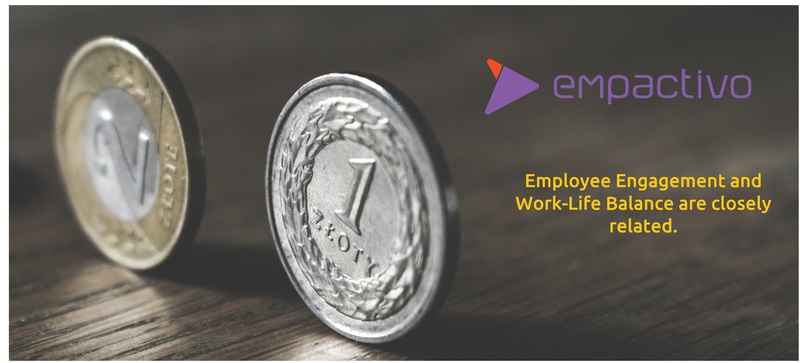Employee engagement and work life balance are closely related. Work is a big part of our lives and a happy and peaceful atmosphere at the workplace helps us to be engaged in life itself. Because as human beings we need to feel appreciated, productive, and seen. We also have the need to be able to change things. So, in this blog post, we will talk about what work-life balance is and how it affects employee engagement. We will be talking about the role of freedom, essential components of work and life balance, the effects of working from home, and more… Let’s go!
To Start…
Employees in today’s competitive labor market face a wide range of difficulties. Some professions allow for a flexible balance of work and personal time, while others need major concessions in both areas. While it’s true that Italians put in fewer hours per week than employees in other EU nations, the work-life balance—the ideal of having a good balance between work and personal life—is a rising phenomenon all around the globe.
It’s not only employees who care about work-life balance these days; more and more businesses are also taking steps to improve their employees’ ability to strike a healthy balance between their professional and personal lives. The objective is to improve employees’ well-being and happiness in addition to their productivity.
Having a good work-life balance is no longer just a pipe dream: These days, it’s becoming more important for businesses to hire people who can maintain their own emotional equilibrium, as their success depends heavily on the happiness and productivity of their staff. Whether intentional or not, squeezing the lives of employees too tightly in the grasp of work, whether by excessive hours worked or inhumane manifestations, will surely lead to discontent, tension, and evident alienation among employees.
Employee Engagement and Work Life Balance
Having a good work-life balance means having a healthy equilibrium between your professional and personal responsibilities. It’s a genuine existential idea that puts equal responsibility on both the employer and the employee by seeing the latter’s pleasure as the key to the former’s success in the workplace.
The widespread discontent among employees suggests that achieving a work-life balance is still an ideal rather than a reality. There has been a gradual shift in the business sector, however, and more and more organizations are embracing and actively promoting a good work-life balance.
There is no longer any doubt that a healthy work-life balance is beneficial for everyone concerned. However, the “happy employee” notion is still a cause of misunderstanding and suspicion at certain levels of management, and it is frequently overlooked in our performance-oriented world.
What is frequently missed, though, is that employees are not automatons that can keep going and going all day long, only stopping to eat and sleep at night. Individuals need to have a job in order to have a place to live.
It is the employer’s responsibility to set a good example when it comes to work-life balance; he or she should not see themselves as the ultimate authority over their employees’ lives, but rather as a trustworthy partner who makes a decent living possible. Companies often must strike a delicate balance between providing employees with opportunities to enhance their personal lives and holding them accountable for their job.
The Range of Freedom: Employee Engagement and Work Life Balance
“How much freedom can I offer my employees?” is a question many companies ask themselves. How much self-control should I impose? The management of the company believes that employees would take advantage of their employer’s goodwill if they were given too much leeway to execute their jobs.
Employees share the ultimate responsibility for achieving a healthy work-life balance. It’s important to remember that we’re discussing striking a balance, not downplaying the value of labor in favor of a more careless way of life.
On the other hand, there are businesses whose work dynamics have an excessively negative impact on employees’ personal and family lives, such as through excessive overtime demands, which reduces employees’ personal time, and through the application of undue stress in the workplace, which can lead to depressive feelings even when employees are not on the clock. Work becomes like a shadow in your personal life when it gets too pervasive.
An economic system where growth is still the core shared precept, but pleasure is a totally individual affair sometimes leads to overwork, despair, and burnout syndrome. The idea of a work-life balance emerges in this context with the goal of making a strong intervention to undermine this structure.
How to Strike a Balance Between Job and Personal Life?
Work-life balance is the practice of incorporating as many of these interrelated elements into one’s professional and personal lives as feasible without negatively impacting the other. Understanding the components of both a successful professional and personal life, as well as their interdependencies, is crucial.
It’s important to keep in mind that many of the elements mentioned below may interact with one another across categories (for instance, the factors “social work environment” and “friends” may frequently overlap in the context of one’s professional and personal lives). It’s also worth emphasizing that each person has unique requirements in each of these areas of life. One employee is satisfied to spend just the right amount of time with his family to maintain a good private life, while the other places a higher priority on his own hobbies and interests but is not (yet) interested in his own family planning.

Essential Components for Employee Engagement and Work Life Balance
Having a good work-life balance depends on the quality of both your professional and personal life, not only how they relate to one another. There will be ripple effects across the organization if employees take their job stress home with them, and likewise if personal issues cause them to be distracted from their work. Obviously, to strike a healthy work-life balance, several requisites must first be met, transforming the job into one that does not impede the employee’s personal satisfaction.
In an ideal world, this contentment would serve as the bedrock and driving force behind a fruitful and harmonious working partnership. Here are some ideas from our previously posted blog to use if you need further information on this topic.
Achieve Something Worthwhile
To many employees, the key to a happy and fulfilling career is doing work that has real, tangible benefits. For the sake of this definition, “working productively” does not refer to maximizing one’s earnings at the cost of other considerations, but rather to doing the most beneficial amount of work possible for each employee. An unpleasant workload, for instance, might cause an employee to feel alienated from his job and have a detrimental influence on his performance in a variety of areas.
When there is a balance between enjoyable and necessary tasks, the work becomes productive. If the boss makes it easy for employees to do their best, employee motivation is likely to be strong. Negative effects on one’s personal life might result from bringing work-related stress into one’s home. Therefore, the quality of work and the employee’s contentment with their employees have a significant impact on the work-life balance.
Respect Effort
The participation of the employer is crucial at this juncture. Most employees can’t feel proud to call themselves professionals unless they have a healthy respect for themselves and their work. To be more precise, we are not only talking about ideal rewards like praise, but also about genuine reward systems like open doors in the workplace, competitive compensation, and other monetary incentives.
People in the workforce want to be respected and valued as the unique individuals they are and want to become. Companies that ignore this fact treat their employees like automatons whose only purpose is to provide the same result repeatedly. The term “job appreciation” refers to the simple act of acknowledging and praising an employee for a job well done.
Get to Know Your Employees
Some people spend so much time with their employees that they start to think of them as a “second family.” Considerably greater weight should be given to the social dynamics of the workplace because of this. Human relationships are notoriously hard to shape since they are dependent on so many different variables. But bosses may create an environment where employees feel comfortable talking to one another and professional relationships flourish. To that extent, it’s essential to have things like an open workplace, regulations against anti-social characteristics like bullying and intolerance, team-building exercises, and a defined hierarchy or social structure. We can proudly say that the mobile employee experience app Empactivo is very well designed for that.
Workplace Schedule and Corporal Flexibility
Time management is a big part of what people mean when they talk about having a “work-life balance,” but that’s not the whole picture. Having said that, timing correctly is crucial to harmony and serves as a foundation for many other variables. The company may take a variety of measures to ensure that their employees have sufficient time for personal and family commitments in addition to their job obligations. One trend in the workplace is the rise of the “home office,” where professionals do their duties from the comfort of their own homes. The business allows the employee to work remotely from home during regular business hours. A computer and access to the Internet are often all that is required.
Encouraging a Healthy Diet and Exercise for Your Workforce
Employee Engagement and work life Balance are related to one’s overall health. There are several factors that compromise employees’ safety and health. There are actions that the company may do in response to this. Back-friendly workplace equipment (excellent seats, height-adjustable desks, high tables, etc.) is great, but it’s also important to provide opportunities for physical activity and health education (back exercises, yoga, pilates, etc.).

Working from Home
When we talk about work-life balance, to be able to have engaged employees after the huge mind shift in the business world, we should also talk about the impacts of smart working. Since the employee is not restricted by the constraints of a conventional office, he or she is free to operate in a more natural setting (dress code, fixed times for breaks, social pressure, noise, and so on).
Commuting time has been eliminated, giving the employee extra leisure time.
If they do their jobs well, parents can spend more time with their significant other and/or children. As we have been talking about employee engagement and work-life balance, now we can easily say that work-life can only be in balance if the personal life is in balance.
There are some drawbacks to working from home, though. For one, since the employee is not under the same level of social pressure as he would be in a traditional office setting, he may abuse his freedom and divert time that should be spent working to other pursuits.
In addition, many people find it challenging to focus on work while at home, thus this metric should not be seen as a universal method of establishing a healthy work-life balance.
Schedules in an Online Setting
With adaptable schedules, things are different. The more flexibility an employee is given in terms of when his workday begins and ends when he takes breaks, and how his hours are distributed throughout the week, the more easily they will be able to balance his professional and personal commitments. This is already the case in many modern companies; for instance, it is normal practice to allow employees to choose their own arrival and departure times from the office, so long as they fall within the scope of their employment contract.
